Contents
Common rhizopogon (Rhizopogon vulgaris) is a rare representative of the Rhizopogon family. It is often confused with white truffle, which is actively used by scammers selling rhizopogons at a high price.
Another species is called:
- truffle ordinary;
- truffle ordinary;
- rhizopogon normal.
Where do common rhizopogons grow
Common rhizopogon is a little-studied mushroom that is rarely found in the forest. The finding of this species is an infrequent occurrence, because fruiting bodies are almost completely hidden under a layer of soil. But if one is found, others will definitely be found nearby – rhizopogons never grow alone.
Rhizopogon ordinary settles in spruce and pine forests, less often in mixed forests. Mushrooms grow in the soil under fallen leaves in close proximity to the trunks of coniferous trees. On the surface, only single mycelial strands can be seen. Sometimes there are surface specimens, but for the most part, the fruiting body of the common rhizopogon is deeply buried in the ground. The season of active fruiting falls on June-October.
What do ordinary rhizopogons look like
Rhizopogon ordinary outwardly very much resembles a small potato tuber. The fruiting body is irregularly rounded or tuberous, 1 to 5 cm across. The skin of young mushrooms is velvety, but as the rhizopogon grows, it becomes smooth and cracked in places. The color of the outer shell is grayish-brown, in mature specimens it acquires an olive-brown hue with yellowness.
The flesh of the rhizopogon is dense, oily, light, almost tasteless and odorless. Old mushrooms are yellowish inside, and sometimes even brown-green. The structure of the pulp consists of small cavities in which the spore powder ripens. The spores are elliptical in shape, oily, yellowish in color. At the bottom of the fruiting body, rhizomorphs can be seen – white threads of the mycelium.
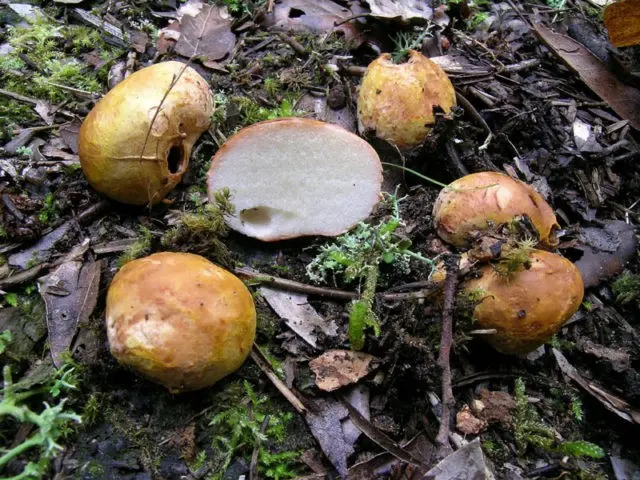
Is it possible to eat common rhizopogons
There is little scientific information about the common rhizopogon, however, many mycologists consider it edible. Only young fruiting bodies should be eaten until the flesh has darkened.
Taste qualities of the common rhizopogon mushroom
This species, along with other edible representatives of the genus, as well as with raincoats, belongs to the fourth taste category. Due to the fact that rhizopogons are rarely found, information about their gastronomic value is reduced to a comparison with the taste of a real puffball (Lycoperdon perlatum).
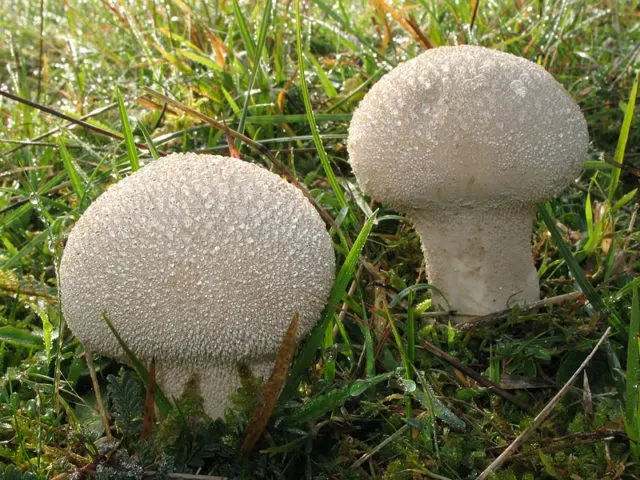
Benefits and harm to the body
Mushrooms are a low-calorie and nutrient-rich product, not without reason they are called “forest meat”. The mineral composition is similar to fruits, carbohydrate – with vegetables. However, in order to avoid poisoning, the preparation technology must be strictly observed. Common rhizopogons are not recommended for pregnant women, nursing mothers and children under seven years of age.
False doubles
In appearance, the common rhizopogon is similar to the very rare mushroom Melanogaster dubious (Melanogaster ambiguus), a gasteromycete of the Svinushkovye family. Its fruiting body is represented not by a cap and a stem, but by a complete gasterocarp with a dense shell and a fruit-bearing gleba. The surface of the fungus is at first dull and velvety, painted in gray-brown tones. As it matures, the peridium takes on a yellow-olive color with dark brown spots resembling bruises. Old mushrooms are black-brown with a whitish bloom.
Inside, the young melanogaster is whitish with black-blue chambers; in adulthood, the flesh darkens significantly, becoming red-brown or black with whitish streaks. At the beginning of growth, the mushroom exudes a pleasant sweetish fruity aroma, but over time it is replaced by the fetid smell of decaying onions or rubber. Information about the possibility of use is contradictory: some experts consider the mushroom edible at a young age, others refer to inedible species.
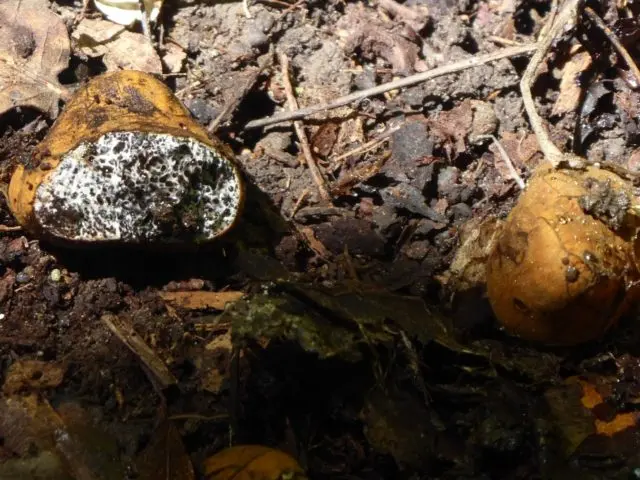
Not surprisingly, the common rhizopogon is similar to other fungi of the genus Rhizopogon, in particular, the yellowish rhizopogon (Rhizopogon luteolus). The fungus is distributed in the temperate zone and in the north of Eurasia, prefers light sandy soils of pine forests.
The surface of the fruit body at a young age is whitish-olive or light brown, later darkens to brown and cracks. The skin is entangled with brown-gray threads of mycelium. The flesh is yellowish-white at first, changing color to yellow-olive or greenish-brown with age. Old mushrooms are almost black inside. Rhizopogon yellowish is considered a conditionally edible product with low taste, when fried it looks like a raincoat.
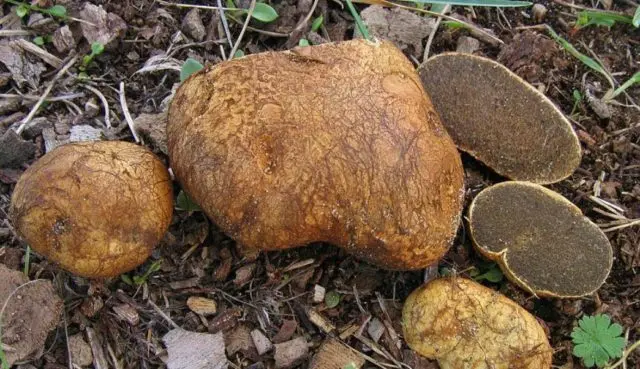
Another twin of the common rhizopogon is the pinkish rhizopogon (Rhizopogon roseolus), also called the pinking or reddening truffle. The species is distinguished by a yellowish skin, which turns pink when pressed, as does the flesh when cut or broken. The places and growing season of the pinking truffle are identical to the common rhizopogon. The view is conditionally edible.
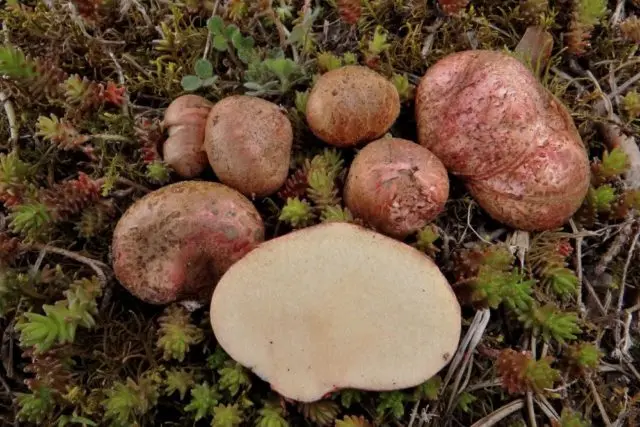
According to external data, the common rhizopogon can be confused with the edible white truffle. The valuable double also has a brownish color and a tuberous shape, but it is more sinuous and rough.
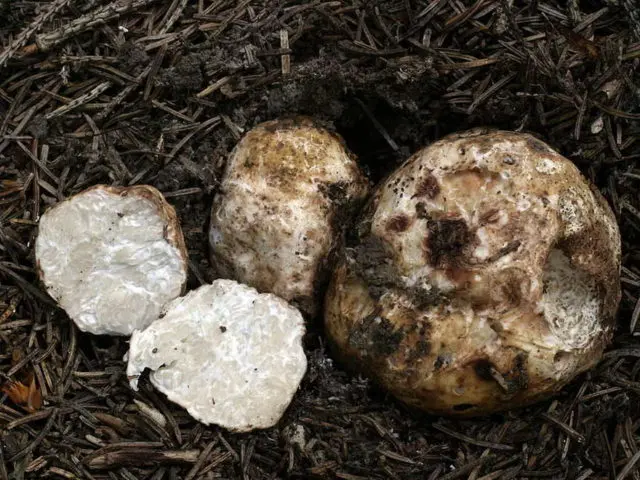
Collection rules
Common rhizopogons should be looked for in the ground near pines, where whitish threads of mycelium are visible. Only young fruits are suitable for food, the pulp of which is distinguished by its density and light shade. Rhizopogons should be collected in ecologically clean areas, away from industrial enterprises and busy highways. You also need to be guided by the rule “not sure – do not take it.”
Use
Common rhizopogons are prepared similarly to all known raincoats. First, the tuber-like fruiting bodies are thoroughly washed under running water, removing dirt and plant debris. Before heat treatment, mushrooms are peeled, which has an unpleasant aftertaste. Having got rid of it, the rhizopogons are crushed and prepared, namely:
- fry;
- stewed;
- they cook;
- baked.
Conclusion
Rhizopogon ordinary is a strange and unusual mushroom with the appearance of a potato and the taste of a raincoat. Having found it in the forest, there is no need to rush, it is worth carefully examining the soil around, because others are probably hiding nearby.









